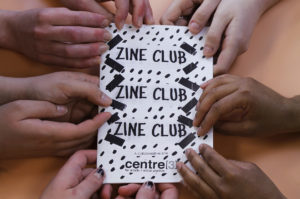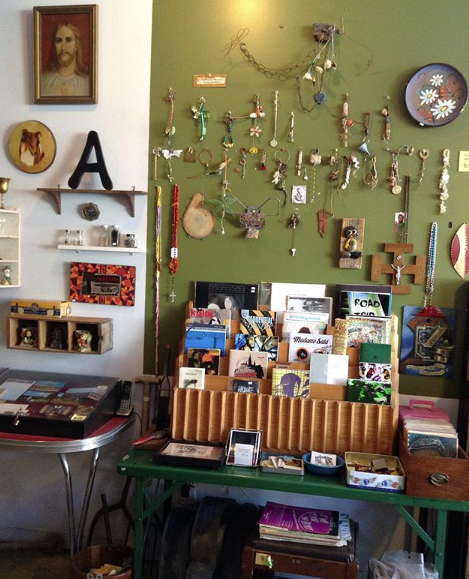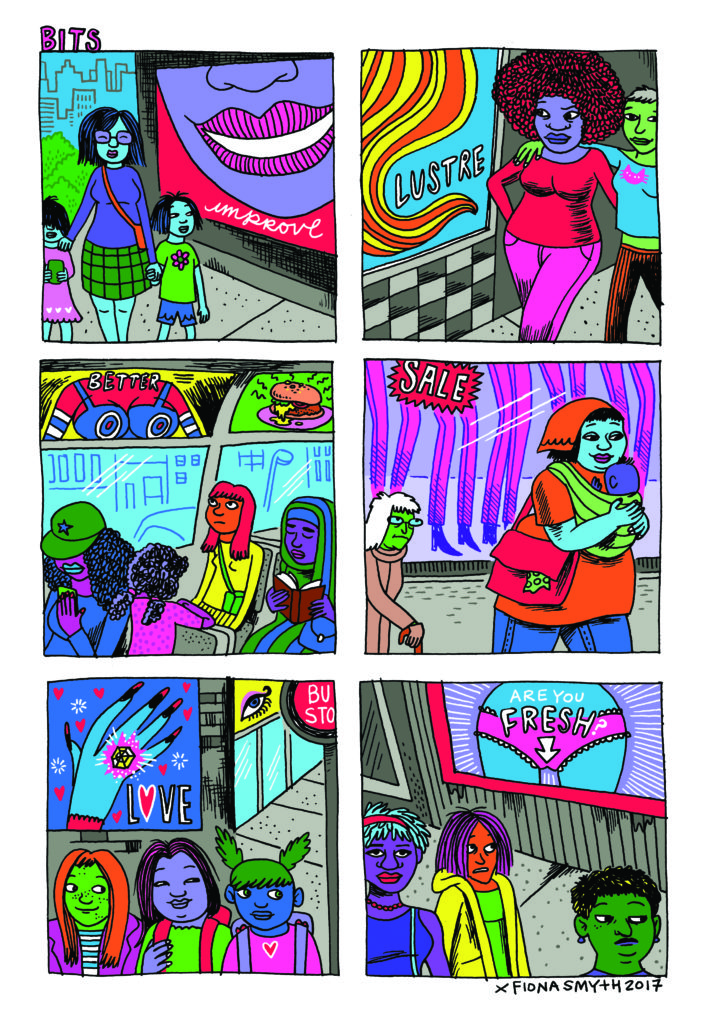“Zines are traditionally an outsider’s medium, free of gatekeepers and gatekeeping,” says zine artist and curator Tara Bursey. “Now, with the internet exposing everything that was once underground, many people know about zines and have an interest in learning to make them as an extension of their creative practices.” She cites the zine fairs and shows being hosted by spaces like the Art Gallery of Ontario (our very own Canzine!) and Art Gallery of Hamilton as evidence of a new interest in self-publishing as an art form — not the least of which is My Back Pages, the AGH’s upcoming interactive exhibition and residency series.
My Back Pages opens a space for new audiences to learn about zines culture and try their hand at creating their own publication. As part of the project, the gallery has also created a residency for emerging and veteran zinesters to create site-specific work for the gallery’s Living Room space, and showcase their zines and related drawings, prints, collages and comics. With the help of various community partners, the show positions zines and indie publishing within the context of today’s social, cultural and political landscape.
We chatted with Bursey, curator of My Back Pages: The Art of Zines and Indie Publishing about self-expression, democracy, stories and survival.

My Back Pages: The Art of Zines and Indie Publishing is a unique interactive exhibition that will teach people about zines as a mode of self-expression, connect them with the work of emerging and veteran zinesters, and allow them to try their hand at making zines. From the opening of the exhibition until November, new work will be added to the space by exhibition “residents.” The exhibition will kick off this week with an installation by The Centre [3] Zine Club—a group of over 20 emerging zinesters working out of Centre [3], a Hamilton artist’s run centre focused on print culture and community art. Next month, they will lead a “zine crit” night and occupy the space during Hamilton Zineposium, a zine fair that will happen at the Art Gallery of Hamilton for the first time in July.
Later, veteran artists and zinesters Billy Mavreas (Montreal) and Fiona Smyth (Toronto) will create a site-specific assemblage and mural respectively in the space. It is exciting that zine makers and indie artists at different stages will occupy the same space, exhibiting converging and diverging perspectives on indie publishing, from identity and feminism to the freedom of expression and creative abandon that comes with making zines. As the exhibition goes on, Billy and Fiona will also be leading talks and workshops on zine making.
How did you go about curating this collection? Is it mainly Canadian content?

The goal of the exhibition was to bring together zinesters of all ages and stages of zine making. All the featured artists and zine makers are Canadian. I think the members of The Centre [3] Zine Club are all from Hamilton which is great—the show will be a platform to showcase what interests drive young Hamilton zine creators. Billy Mavreas is from Montreal, where he runs a shop called Monastiraki, which is a tribute to print culture and unusual cultural artifacts. Fiona Smyth is from Toronto, where she has been influential in the areas of zines, comics and indie art for decades. Both Fiona and Billy are in THIS IS SERIOUS as well, showing how some artists move fluidly between the overlapping worlds of zines and comics. In addition to the programs and art of the three residents, there will also be a collection of zines that visitors to the exhibition space can explore — they will be selections from the Hamilton Zineposium archive, and from my own collection. We hope that these zines will show the public diverse thematic and visual approaches to zines and serve as inspiration for making their own zines in the exhibition space.
We found a Globe and Mail article from 2006 where you say, “the best thing about zines is that they’re completely democratic. Anyone can make one, and they’re cheap to make and distribute.” Can you speak more on the democratic nature of zines?
Zines can be anything you want them to be. You don’t have to wait for someone to publish you or support your work like a gallerist or institution of higher learning would. While the internet has opened up options for a lot of online modes of self-expression (social media, websites, graphic design templates like Canva), few offer full freedom of design and expression. While there is something democratic about some forms of online communication, there is also a cacophony of voices, information and misinformation to navigate. Zines not only allow for the total creative freedom of the maker, but they are providing valuable respite from the immateriality and rapid-fire speed of the internet. I think many of us are experiencing digital fatigue right now, which is perhaps why people are opting for the slow, personal, narrowcast quality of zines.
In an interview about their zine making practice, Centre [3] Zine Club member Sid Drmay poignantly referred to zine making as an act of survival. This speaks to the transformative power of an art form that is at its core democratic and inclusive. Zines are also a way for stories and experiences to be shared, not perish in the void, and for people to provide mutual support around shared experiences. By handing someone a zine you made, you make a tangible, authentic connection with them in real time. And that is something so many of us can use, in this day and age.
This interview has been edited and condensed for clarity.

Come out and celebrate the launch of the AGH‘s summer season exhibitions, including My Back Pages: The Art of Zines and Indie Publishing on June 20th! Special exhibition admission is free from 4-10pm.
